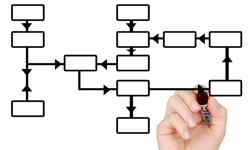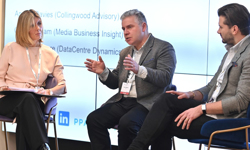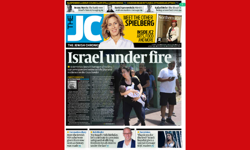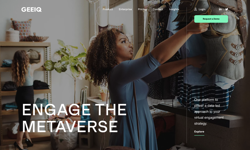Opening the event, conference organiser Carolyn Morgan said that 2013 was the year for “redefining and reinventing” specialist media, and, certainly, the day was full of examples of the changing nature of publishing. Total Telecom’s Rob Chambers talked us through his company’s journey, from publishing four print magazines seven years ago, to publishing none today. Instead, they have one digital-only publication, a website, a TV channel and a flourishing events business which brings in two thirds of the company’s revenues.
Events is an increasingly vibrant and growing part of many publishers’ portfolios and Ben Wood showed how Incisive Media was taking advantage of lower barriers to entry to launch new events into markets where they had no previous presence, like Cement Focus Asia. They started with no brand, no data and no foothold in the market, and the event turned out to be a great success! “Be bold and back your judgement”, said Ben.
E-commerce is also having an increasingly dramatic effect on publishers’ revenues. For MyTime Media, Owen Davies said that it now accounted for over fifty per cent of their revenues and he advised publishers to get started, although he did urge a degree of caution. Skills like warehouse management, stock control and purchasing are new to most publishers, so he advised new entrants to form partnerships in the first instance.
In the mass market, e-commerce tie ups, as seen in women’s titles like Grazia, are growing in importance, mirroring and countering the increasing incursions of retailers like Net-a-Porter and Assos into the publishing space. As Carolyn Morgan said, the combination of content and e-commerce, and the power of community endorsement, is a potent one.
As Colin Morrison said in his keynote address, publishers should be looking to create services, not products and this point was echoed by Subscription Site Insider’s Minal Bopaiah, who said that of US subscription sites, 85% of them were planning to launch SaaS services over the coming twelve months. (It should be noted that 75% also planned to launch new print products.)
The changing role of print
The growth of these new services highlighted the decline in our traditional platforms, and there were many examples during the day of publishers’ retreat from print. Immediate Media’s Cath Waller pointed to research which showed print advertising declining by 10% in 2012, and digital advertising increasing by 15%, albeit from a lower start point. Yet the situation was variable and differed from publisher to publisher. While I can’t recall anyone saying that their print offering was actually growing, there were some speakers, like IDG’s Marcus Wilkinson talking about CIO magazine, who insisted that the print edition was absolutely essential for that title’s brand presence, and although print revenues were declining, the existence of the print title was the corner stone of the broader brand offering. And I think it was Marcus who said that the top people in CIO’s market sector were only too happy to be interviewed for the print edition, but just you try getting them to take part in an interview for the website only. For many titles, print is very far from dead. It is an important element of a multi-pronged publishing strategy, albeit one with a declining revenue profile.
“It is my belief”, said Carolyn Morgan, “that a vibrant community is at the heart of a successful specialist publisher.” Community was a central theme throughout the day. Colin Morrison spoke of how digital had changed forever the nature of our relationship with our audience. Many of the individual components of the modern publisher’s offering are not new; events, conferences and other networking opportunities preceded the digital age, as did, to a lesser extent user generated content (remember the letters page!), but what digital has done is to deepen that relationship and make it 24/7, in a way that simply was not possible before.
One of the slides in Colin’s presentation was headed ‘The Essentials’, and top of the list was ‘audience relationships’. “The most important thing is”, he said, “to get close to your community; if you don’t then someone else will take the opportunity to come and eat your lunch.”
By getting close to your community, and fully understanding their needs, you will also be able to better answer some of the many questions facing publishers today: paywall or free, mass market or niche, mobile or desktop, hard copy or online.
By becoming, in effect, a community organiser you can maximise your revenue opportunities by surrounding your community with commercial offerings. For Briefing Media’s Louise White, talking about Farmers Guardian, the only metric she cared about was ARPU (average revenue per user). Her aim was, quite simply, to make more money out of existing loyal readers; currently the ARPU stood at £60 per annum, but her target was to increase that, first to £90, and ultimately to £150, by increasing the range of services Farmers Guardian offered their readers.
Valuing digital
There was general agreement from most of the speakers that maximising revenues meant not undervaluing digital. “Virtual doesn’t mean free”, said Dennis Publishing’s Sarah Aldridge. It was, she continued, important to show that digital had a value, and Dennis had a policy of trying to keep the digital-only subscription price within £10 of the print-only, and they eschewed the policy, still in favour at some large publishers, where print subscribers would get free access to the iPad version.
Yet, clearly, many publishers were struggling to repair the damage of previous strategies which had left many consumers with the expectation that digital should either be free, or a lot cheaper than print.
For Carolyn Morgan, the price of the digital subscription should be no lower than the print subscription, although she recognised that legacy issues meant that there was a gap between what publishers wanted to charge and what consumers expected to pay, and that publishers needed a strategy to close that gap and converge the pricing over time.
Consumers need re-educating, because, as Louise White said, “the biggest lie in publishing is that digital is cheaper than print.”
Going native
Similarly, on the commercial side, said Intent Media’s Stuart Dinsey, publishers needed to get out of the habit (or avoid the temptation) to give “free of charge web space to print advertisers”.
Some of the greatest changes have been seen on the commercial side of the business, where the fact that everyone’s a publisher now has turned the commercial proposition for most publishers on its head. When brands can go direct to the consumer, the old business model based on controlling the communication channel is truly dead and buried.
According to Colin Morrison, most advertisers today expected to have a direct response element and display was “being blown out of the water, because there’s no proof that it’s working”.
“The conversations we’re having with customers are changing”, said IDG’s Marcus Wilkinson. “They are talking about deeper engagement and sales people need to add value.”
Stuart Dinsey said: “it’s less about selling ads than ever; just selling pages is asking for trouble; what companies want are integrated campaigns.” Publishers are increasingly selling engagement rather than reach.
Publishers should sell packages of activities, which will increasingly involve an element of sponsored content / advertorial / native advertising (call it what you will, although Marcus Wilkinson says that getting the language right is important and that, in his experience, “call it ‘native’ and you have the client’s attention”).
For Immediate’s Cath Waller, display is still the biggest element of commercial revenue, but it is being squeezed by, on the one hand, high value sponsorship and integration solutions, and on the other, by high volume, low yield digital space, via agency digital networks.
Selling high value, deep level integrations and sponsorship was a key part of Immediate Media’s strategy and they had restructured their business to facilitate the delivery of creative solutions. They abolished separate digital sales teams, invested in training and put digital people in integrated teams. “It’s all about structure”, said Cath.
Similarly, the traditional boundaries between the editorial and advertising teams are also coming down. According to Stuart Dinsey, it is absolutely essential that advertising and editorial teams work together. Collaboration is key. The role of editorial was critical to the delivery of genuinely creative content solutions. The solutions being offered need to be bespoke, original and innovative. In other words, there is nothing transactional about the selling of advertising today.
Attend any media conference nowadays, and you will know that change is the only constant. The good news for the assembled delegates was, said Colin Morrison, that specialist media publishers were better placed than their mass media rivals to ride the wave of change. “The future belongs”, he said, “to versatile, responsive and innovative media that use the technology to really understand and meet the changing appetite of audiences.”












